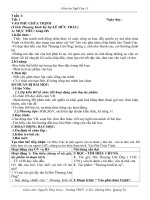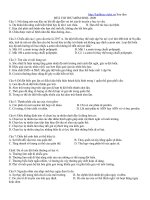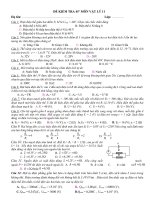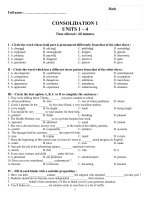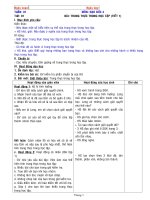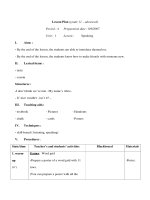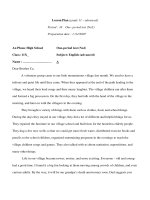Api mpms 11 4 1 2003 (american petroleum institute)
Bạn đang xem bản rút gọn của tài liệu. Xem và tải ngay bản đầy đủ của tài liệu tại đây (342.35 KB, 26 trang )
Manual of Petroleum
Measurement Standards
Chapter 11—Physical Properties
Data
Section 4—Properties of Reference Materials
Part 1—Density of Water and Water
Volumetric Correction Factors for
Water Calibration of Volumetric
Provers
FIRST EDITION, DECEMBER 2003
--```,,`-`-`,,`,,`,`,,`---
Copyright American Petroleum Institute
Reproduced by IHS under license with API
No reproduction or networking permitted without license from IHS
Not for Resale
--```,,`-`-`,,`,,`,`,,`---
Copyright American Petroleum Institute
Reproduced by IHS under license with API
No reproduction or networking permitted without license from IHS
Not for Resale
Manual of Petroleum
Measurement Standards
Chapter 11—Physical Properties
Data
Section 4—Properties of Reference Materials
Part 1—Density of Water and Water
Volumetric Correction Factors for
Water Calibration of Volumetric
Provers
Measurement Coordination Department
FIRST EDITION, DECEMBER 2003
--```,,`-`-`,,`,,`,`,,`---
Copyright American Petroleum Institute
Reproduced by IHS under license with API
No reproduction or networking permitted without license from IHS
Not for Resale
SPECIAL NOTES
--```,,`-`-`,,`,,`,`,,`---
API publications necessarily address problems of a general nature. With respect to particular circumstances, local, state, and federal laws and regulations should be reviewed.
API is not undertaking to meet the duties of employers, manufacturers, or suppliers to
warn and properly train and equip their employees, and others exposed, concerning health
and safety risks and precautions, nor undertaking their obligations under local, state, or federal laws.
Information concerning safety and health risks and proper precautions with respect to particular materials and conditions should be obtained from the employer, the manufacturer or
supplier of that material, or the material safety data sheet.
Nothing contained in any API publication is to be construed as granting any right, by
implication or otherwise, for the manufacture, sale, or use of any method, apparatus, or product covered by letters patent. Neither should anything contained in the publication be construed as insuring anyone against liability for infringement of letters patent.
Generally, API standards are reviewed and revised, reafÞrmed, or withdrawn at least every
Þve years. Sometimes a one-time extension of up to two years will be added to this review
cycle. This publication will no longer be in effect Þve years after its publication date as an
operative API standard or, where an extension has been granted, upon republication. Status
of the publication can be ascertained from the API Standards department telephone (202)
682-8000. A catalog of API publications, programs and services is published annually and
updated biannually by API, and available through Global Engineering Documents, 15 Inverness Way East, M/S C303B, Englewood, CO 80112-5776.
This document was produced under API standardization procedures that ensure appropriate notiÞcation and participation in the developmental process and is designated as an API
standard. Questions concerning the interpretation of the content of this standard or comments and questions concerning the procedures under which this standard was developed
should be directed in writing to the Director of the Standards department, American Petroleum Institute, 1220 L Street, N.W., Washington, D.C. 20005. Requests for permission to
reproduce or translate all or any part of the material published herein should be addressed to
the Director, Business Services.
API standards are published to facilitate the broad availability of proven, sound engineering and operating practices. These standards are not intended to obviate the need for applying sound engineering judgment regarding when and where these standards should be
utilized. The formulation and publication of API standards is not intended in any way to
inhibit anyone from using any other practices.
Any manufacturer marking equipment or materials in conformance with the marking
requirements of an API standard is solely responsible for complying with all the applicable
requirements of that standard. API does not represent, warrant, or guarantee that such products do in fact conform to the applicable API standard.
All rights reserved. No part of this work may be reproduced, stored in a retrieval system, or
transmitted by any means, electronic, mechanical, photocopying, recording, or otherwise,
without prior written permission from the publisher. Contact the Publisher,
API Publishing Services, 1220 L Street, N.W., Washington, D.C. 20005.
Copyright © 2003 American Petroleum Institute
Copyright American Petroleum Institute
Reproduced by IHS under license with API
No reproduction or networking permitted without license from IHS
Not for Resale
FOREWORD
API publications may be used by anyone desiring to do so. Every effort has been made by
the Institute to assure the accuracy and reliability of the data contained in them; however, the
Institute makes no representation, warranty, or guarantee in connection with this publication
and hereby expressly disclaims any liability or responsibility for loss or damage resulting
from its use or for the violation of any federal, state, or municipal regulation with which this
publication may conßict.
Suggested revisions are invited and should be submitted to API, Standards department,
1220 L Street, NW, Washington, DC 20005.
iii
--```,,`-`-`,,`,,`,`,,`---
Copyright American Petroleum Institute
Reproduced by IHS under license with API
No reproduction or networking permitted without license from IHS
Not for Resale
--```,,`-`-`,,`,,`,`,,`---
Copyright American Petroleum Institute
Reproduced by IHS under license with API
No reproduction or networking permitted without license from IHS
Not for Resale
CONTENTS
Page
1
INTRODUCTION . . . . . . . . . . . . . . . . . . . . . . . . . . . . . . . . . . . . . . . . . . . . . . . . . . . . . . 1
2
SCOPE . . . . . . . . . . . . . . . . . . . . . . . . . . . . . . . . . . . . . . . . . . . . . . . . . . . . . . . . . . . . . . . 1
3
REFERENCES . . . . . . . . . . . . . . . . . . . . . . . . . . . . . . . . . . . . . . . . . . . . . . . . . . . . . . . . 1
4
DEFINITIONS. . . . . . . . . . . . . . . . . . . . . . . . . . . . . . . . . . . . . . . . . . . . . . . . . . . . . . . . . 1
5
IMPLEMENTATION PROCEDURES . . . . . . . . . . . . . . . . . . . . . . . . . . . . . . . . . . . . .
5.1 Absolute Density of Water. . . . . . . . . . . . . . . . . . . . . . . . . . . . . . . . . . . . . . . . . . .
5.2 Volume Correction Factors for Water . . . . . . . . . . . . . . . . . . . . . . . . . . . . . . . . . .
5.3 Water Volume Correction Factors for Volumetric Provers . . . . . . . . . . . . . . . . . .
6
ROUNDING . . . . . . . . . . . . . . . . . . . . . . . . . . . . . . . . . . . . . . . . . . . . . . . . . . . . . . . . . . 3
7
EXAMPLES . . . . . . . . . . . . . . . . . . . . . . . . . . . . . . . . . . . . . . . . . . . . . . . . . . . . . . . . . .
7.1 Prover Volume, Measure Temperature Higher Than Prover
Temperature (USC Units) . . . . . . . . . . . . . . . . . . . . . . . . . . . . . . . . . . . . . . . . . . .
7.2 Prover Volume, Measure Temperature Lower Than Prover
Temperature (USC Units) . . . . . . . . . . . . . . . . . . . . . . . . . . . . . . . . . . . . . . . . . . .
7.3 Volume of Water at 60¡F (USC Units) . . . . . . . . . . . . . . . . . . . . . . . . . . . . . . . . .
7.4 Prover Volume, Measure Temperature Higher Than Prover
Temperature (SI Units) . . . . . . . . . . . . . . . . . . . . . . . . . . . . . . . . . . . . . . . . . . . . .
7.5 Prover Volume, Measure Temperature Lower Than Prover
Temperature (SI Units) . . . . . . . . . . . . . . . . . . . . . . . . . . . . . . . . . . . . . . . . . . . . .
7.6 Volume of Water at 15¡C (SI Units) . . . . . . . . . . . . . . . . . . . . . . . . . . . . . . . . . . .
APPENDIX A
APPENDIX B
APPENDIX C
APPENDIX D
APPENDIX E
1
1
2
2
3
3
3
4
4
4
4
REPRESENTATIVE DENSITY VALUES . . . . . . . . . . . . . . . . . . . . . . . 5
REFERENCE STANDARD WATER. . . . . . . . . . . . . . . . . . . . . . . . . . . . 7
TANAKA VS PATTERSON EQUATION. . . . . . . . . . . . . . . . . . . . . . . . 9
CORRECTION FOR DISSOLVED AIR . . . . . . . . . . . . . . . . . . . . . . . . 11
CORRECTION FOR COMPRESSIBILITY. . . . . . . . . . . . . . . . . . . . . . 13
--```,,`-`-`,,`,,`,`,,`---
Tables
1
SigniÞcant Digits. . . . . . . . . . . . . . . . . . . . . . . . . . . . . . . . . . . . . . . . . . . . . . . . . . . . 3
v
Copyright American Petroleum Institute
Reproduced by IHS under license with API
No reproduction or networking permitted without license from IHS
Not for Resale
--```,,`-`-`,,`,,`,`,,`---
Copyright American Petroleum Institute
Reproduced by IHS under license with API
No reproduction or networking permitted without license from IHS
Not for Resale
Chapter 11—Physical Properties Data
Section 4—Properties of Reference Materials
Part 1—Density of Water and Water Volumetric Correction Factors
for Water Calibration of Volumetric Provers
1 Introduction
ter at 15¡C). Density is assumed to be for water at atmospheric pressure unless otherwise stated.
This Standard speciÞes the density of water to be used in
all applicable API MPMS Standards. It also speciÞes the volume correction factor equation for water and demonstrates its
use for water calibration of volumetric provers (see API
MPMS Chapters 12.2.1, 12.2.3).
This standard is applicable to all API Standards that use the
density of water or its volume correction factors.
4.2 volume correction factor (VCF): The density of a
liquid at temperature t divided by its density at a chosen reference temperature. Multiplying a liquidÕs volume measured at temperature t by the VCF provides the volume of
the liquid at the chosen reference temperature. Volume Correction Factors are assumed to be for water at atmospheric
pressure unless otherwise stated. Certain API MPMS Chapters call this factor CTDW.
3 References
5 Implementation Procedures
2 Scope
--```,,`-`-`,,`,,`,`,,`---
The implementation procedures below are the standard.
Representative density values are presented in the Appendix
A for programming veriÞcation purposes only.
H. Wagenbreth and H. Blanke, ÒThe Density of Water in
the International System of Units and in the International Practical Temperature Scale of 1968,Ó
Mitteilungen der Physikalish-Technischen Bundesanstalt (PTB–Mitt), 412Ð415, June 1971.
G.S. Kell, Journal of Chemical Engineering Data, 1967,
12, 66Ð69; ibid, 1975, 20, 97Ð105.
N. Bignell, ÒThe Effect of Dissolved Air on the Density of
Water,Ó Metrologia, 1983, 19, 57Ð59.
J.B. Patterson and E.C. Morris, ỊMeasurement of Absolute
Water Density,Ĩ Metrologia, 31, 277Ð288, 1994.
M. Tanaka, G. Girard, R. Davis, A. Peuto and N. Bignell,
ÒRecommended table for the density of water
between 0¡C and 40¡C based on recent experimental reports,Ó Metrologia, 38, 301Ð309, 2001.
5.1 ABSOLUTE DENSITY OF WATER
The previous standard (API MPMS 11.2.3, 1984), which
this Standard replaces, was based on the internationally
accepted work of Wagenbreth and Blanke, which produced a
density of 999.012 kg/m3 at 60¡F. In 1994, Patterson and
Morris published a paper proposing a new equation based on
their laboratory data of VSMOW (see Appendix B), which
was accepted by the NIST (National Institute of Standards
and Technology). In 2001, a review (Tanaka, et al.) proposed
a new equation regressed from the data of several researchers
(including that of Patterson and Morris). Although they are
aware of this paper, the NIST at this writing has chosen to
continue to accept the work of Patterson and Morris. This
Standard is therefore based on that same work, applicable
between 1¡C and 40¡C (see Appendix C).
The following equation expresses the density of water as a
function of temperature in degrees Celsius:
4 Definitions
4.1 density, absolute: The density of a solid or liquid
substance at a speciÞed temperature is the mass of the substance occupying a unit of volume at the speciÞed temperature. Density so deÞned is sometimes referred to as Ịtrue
densit or as Ịdensity in vacuo.Ĩ When reporting density, the
units of mass and volume used and the temperature of the
determination must be stated (for example, grams per millili-
r tC = r 0 [ 1 Ð ( ADt + BDt + CDt + DDt + EDt ) ] (1)
2
1
Copyright American Petroleum Institute
Reproduced by IHS under license with API
No reproduction or networking permitted without license from IHS
Not for Resale
3
4
5
API MPMS, CHAPTER 11—PHYSICAL PROPERTIES DATA
2
where
The volume correction factor equation for water referenced
to 60¡F is:
rtC = density at temperature t¡C in kg/m3,
r tC
VCF 60°F = -----------------999.016
r0 = density at temperature t0, 999.97358 kg/m3
(maximum density of water),
Dt = t Ð t 0,
The output of equation (3), (4), and (5) is rounded to no
more than 6 decimal places for further use. Although VCFs
are assumed to be for water at atmospheric pressure unless
otherwise stated, the VCFs for water under pressure are
slightly smaller. As this difference is very small, application
of such VCFs should be contingent upon agreement of both
parties to a transaction after evaluation of the difference.
t0 = 3.9818¡C,
A = 7.0134
x 10-8 (¡C)-1,
B = 7.926504 x 10-6 (¡C)-2 ,
C = -7.575677 x 10-8 (¡C)-3 ,
D = 7.314894 x 10-10 (¡C)-4 ,
5.3 WATER VOLUME CORRECTION FACTORS
FOR VOLUMETRIC PROVERS
E = -3.596458 x 10-12 (¡C)-5 .
The following equation expresses the density of water as a
function of temperature in degrees Fahrenheit:
rtF = r0 [ 1 Ð (ADtF + BDtF2 + CDtF3 + DDtF4 + EDtF5)] (2)
For waterdraw calibrations of volumetric provers, the
prover volume is calculated from the volume of the certiÞed
volumetric Þeld test measure using a VCF based on the densities of water in the prover (deemed the reference density) and
the measure as follows:
r mt
V
VCF pt = ------ = ------pr pt
Vm
where
( °F Ð 32 )
DtF = ---------------------- Ð t0
1.8
r mt
V p = V m * VCF pt = V m * -----r pt
These equations provide the following values:
Density at 60¡F (15.5556¡C):
999.016 kg/m3
Density at 15¡C (59¡F):
999.102 kg/m3
Density at 20¡C (68¡F):
998.206 kg/m3
VCFpt = volume correction factor, prover reference temperature (also called CTDW),
--```,,`-`-`,,`,,`,`,,`---
5.2 VOLUME CORRECTION FACTORS FOR
WATER
The volume correction factor equation for water with
respect to a chosen reference temperature is the density at
temperature t (rtC) divided by the density of water at that reference temperature. For 15¡C, it is:
VCF 15°C
(3)
Similarly, the volume correction factor equation for water
referenced to 20¡C is:
r tC
VCF 20°C = -----------------999.206
Copyright American Petroleum Institute
Reproduced by IHS under license with API
No reproduction or networking permitted without license from IHS
(6)
where
The output of equation (1) and (2) is rounded to three decimal places for further use.
r tC
= -----------------999.102
(5)
rmt = water density at its actual temperature in the
test measure,
rpt = water density at its actual temperature in the
prover,
Vp = prover volume (to be further corrected as indicated in Ch. 12.2.3),
Vm = measure volume (to be further corrected as
indicated in Ch. 12.2.3)
The densities rmt and rpt are calculated from equations (1)
or (2). Correction for dissolved air (see Appendix D) is not
necessary as we are dealing with a density ratio. Vp, the Þnal
result, is rounded to the same number of decimal places as Vm
(see Examples). Correction for pressure compressibility is
provided in Appendix E.
(4)
Not for Resale
SECTION 4 PART 1—DENSITY OF WATER AND WATER VOLUME CORRECTION FACTORS FOR CALIBRATION OF VOLUMETRIC PROVERS
In many cases the number of decimal places that are to be
used is inßuenced by the source of the data itself. For example, if a containerÕs capacity table is calibrated to the nearest
whole barrel, then all subsequent barrel values should be
rounded accordingly. Furthermore, calculation standards such
as MPMS Chapter 12 will specify rounding for each unique
application. However, in those cases where there are no other
limiting factors, the operator should be guided by Table 1.
Each calculated density shall always be rounded off in one
step to three places past the decimal and not rounded in two
or more successive steps. Water Volume Correction Factors
are rounded to six places past the decimal. When the Þgure to
the right of the last place to be retained is less than 5, the Þgure in the last place retained should be unchanged.
Table 1—Significant Digits
Units
Gallons
Barrels
Cubic Meters
Cubic Inches
Pounds
Milliliters
Liters
Kilograms
VCF
Density kg/m3
Density lb/gal.
Relative density
Temperature ¡F
Temperature ¡C
Cpw
No. of Decimals
xxxxx.xx
xxx.xx
xxx.xxx
xxxxx.xxxx
xxx.0
xxxxxx.xxx
xxx.0
xxx.0
x.xxxxxx
xxx.xxx
xx.xxx
x.xxxx
xxx.x
xxx.x5
x.xxxxxx
Solution: Use equation (2) to separately calculate the water
densities rmt and rpt:
r mt = 996.139 kg Ô m
r pt = 996.499 kg ¤ m
7.1
r mt
------- = 0.999639
r pt
From equation (6), the prover volume is calculated to be
(rounded to the same number of decimal places as the test
measure):
r mt
- = 11,547.3299 cubic in. @80.7°F
V p = V m * -----r pt
7.2 PROVER VOLUME, MEASURE TEMPERATURE
LOWER THAN PROVER TEMPERATURE (USC
UNITS)
Problem: During a waterdraw, the water in a prover at
83.0¡F is transferred into a test measure volume of 11,551.50
cubic in. at 80.7¡F. What is the volume of the prover at
83.0¡F?
Solution: Use equation (2) to separately calculate the water
densities rmt and rpt:
r mt = 996.499 kg ¤ m
3
r mt = 996.139 kg ¤ m
3
Their ratio is:
r mt
------- = 1.000361
r pt
PROVER VOLUME, MEASURE TEMPERATURE
HIGHER THAN PROVER TEMPERATURE
(USC UNITS)
Problem: During a waterdraw, the water in a prover at
80.7¡F is transferred into a test measure volume of 11,551.50
cubic in. at 83.0¡F. What is the volume of the prover at
80.7¡F?
3
Their ratio is:
7 Examples
The following examples are for illustration purposes only.
The relevant API MPMS chapters (4.9.2, 12.2.4, etc.) govern
use and rounding for speciÞc applications.
3
From equation (6), the prover volume is calculated to be
(rounded to the same number of decimal places as the test
measure):
r mt
- = 11,555.6701 cubic in. @83.0°F
V p = V m * -----r pt
Copyright American Petroleum Institute
Reproduced by IHS under license with API
No reproduction or networking permitted without license from IHS
Not for Resale
--```,,`-`-`,,`,,`,`,,`---
6 Rounding
3
API MPMS, CHAPTER 11—PHYSICAL PROPERTIES DATA
4
7.3 VOLUME OF WATER AT 60°F (USC UNITS)
Problem: A tank car contains 21,953 gallons of water at
93.4¡F. What is the volume of water at 60¡F in the car?
Solution: Adapting Equation (6):
rt
V 60°F = V m * VCF 60°F = V m * -----------------999.016
The volume V60¡F (intermediate results rounded here for
display only) is thus:
7.5 PROVER VOLUME, MEASURE TEMPERATURE
LOWER THAN PROVER TEMPERATURE
(SI UNITS)
Problem: During a waterdraw, the water in a prover at
21.1¡C is transferred into a test measure volume of 189,214
milliliters at 18.3¡C. What is the volume of the prover at
21.1¡C?
Solution: Use equation (1) to separately calculate the water
densities rmt and rpt:
rmt = 998.541 kg/m3
r 93.4
994.335
- = Vm * ------------------V60¡F = Vm * -----------------999.016
999.016
= 21953 * 0.995314
= 21,850 gallons @60¡F
7.4 PROVER VOLUME, MEASURE TEMPERATURE
HIGHER THAN PROVER TEMPERATURE
(SI UNITS)
Problem: During a waterdraw, the water in a prover at
18.3¡C is transferred into a test measure volume of 189,214
milliliters at 21.1¡C. What is the volume of the prover at
18.3¡C?
Solution: Use equation (1) to separately calculate the water
densities rmt and rpt:
rm
= 997.972 kg/m3
rpt = 998.541 kg/m3
rpt = 997.972 kg/m3
Their ratio is:
rmt = 1.000570
From equation (6), the prover volume is calculated to be
(rounded to the same number of decimal places as the test
measure):
r mt
- = 189,321.852 milliliters @21.1¡C
Vp = Vm * -----r pt
7.6 VOLUME OF WATER AT 15°C (SI UNITS)
Problem: A tank car contains 83,101 liters of water at
34.1¡C. What is the volume of water at 15¡C in the car?
Solution: Adapting Equation (6):
rt
V15¡C = Vm * VCF15¡C = Vm * -----------------999.012
Their ratio is:
r mt
------- = 0.999430
r pt
The volume V15¡C is thus (intermediate results rounded
here for display only):
From equation (6), the prover volume is calculated to be
(rounded to the same number of decimal places as the test
measure):
r 34.1
994.338
- = Vm * ------------------V15¡C = Vm * -----------------999.102
999.102
r mt
- = 189,106.148 milliliters @18.3¡C
Vp = Vm * -----r pt
= 83,101 * 0.995232
= 82,705 liters @15¡C
--```,,`-`-`,,`,,`,`,,`---
Copyright American Petroleum Institute
Reproduced by IHS under license with API
No reproduction or networking permitted without license from IHS
Not for Resale
APPENDIX A—REPRESENTATIVE DENSITY VALUES
¡F
33
34
35
36
37
38
39
40
41
42
43
44
45
46
47
48
49
50
51
52
53
54
55
56
57
58
59
60
61
62
63
64
65
66
67
68
--```,,`-`-`,,`,,`,`,,`---
Copyright American Petroleum Institute
Reproduced by IHS under license with API
No reproduction or networking permitted without license from IHS
¡C
0.6
1.1
1.7
2.2
2.8
3.3
3.9
4.4
5.0
5.6
6.1
6.7
7.2
7.8
8.3
8.9
9.4
10.0
10.6
11.1
11.7
12.2
12.8
13.3
13.9
14.4
15.0
15.6
16.1
16.7
17.2
17.8
18.3
18.9
19.4
20.0
kg/m3
999.878
999.907
999.930
999.949
999.962
999.970
999.974
999.972
999.965
999.954
999.938
999.918
999.893
999.863
999.829
999.791
999.748
999.702
999.651
999.596
999.537
999.474
999.407
999.336
999.262
999.184
999.102
999.016
998.927
998.834
998.738
998.638
998.535
998.429
998.319
998.206
¡F
69
70
71
72
73
74
75
76
77
78
79
80
81
82
83
84
85
86
87
88
89
90
91
92
93
94
95
96
97
98
99
100
101
102
103
104
5
Not for Resale
¡C
20.6
21.1
21.7
22.2
22.8
23.3
23.9
24.4
25.0
25.6
26.1
26.7
27.2
27.8
28.3
28.9
29.4
30.0
30.6
31.1
31.7
32.2
32.8
33.3
33.9
34.4
35.0
35.6
36.1
36.7
37.2
37.8
38.3
38.9
39.4
40.0
kg/m3
998.089
997.970
997.847
997.721
997.592
997.460
997.325
997.187
997.046
996.902
996.755
996.605
996.453
996.297
996.139
995.978
995.814
995.648
995.479
995.307
995.133
994.956
994.776
994.594
994.409
994.222
994.032
993.840
993.645
993.448
993.249
993.047
992.842
992.635
992.426
992.215
--```,,`-`-`,,`,,`,`,,`---
Copyright American Petroleum Institute
Reproduced by IHS under license with API
No reproduction or networking permitted without license from IHS
Not for Resale
APPENDIX B—REFERENCE STANDARD WATER
The Patterson & Morris equation (1) is based on the isotopic composition of VSMOW (Vienna Standard Mean Ocean
Water). VSMOW is so named because it is distributed by the
IAEA (International Atomic Energy Agency) headquartered
in Vienna.
It should be noted that water obtained from other sources
does not have the same isotopic composition and thus has
slightly different densities. Evaporation or distillation shifts
the isotopic composition as molecules with heavier isotopes
of hydrogen and/or oxygen have slightly higher boiling
points. Conversely, rain or snow tends to slightly concentrate
molecules with the heavier isotopes, leaving more of the
--```,,`-`-`,,`,,`,`,,`---
Copyright American Petroleum Institute
Reproduced by IHS under license with API
No reproduction or networking permitted without license from IHS
lighter molecules in the air. The result is that fresh water varies widely in isotopic composition around the earth. However,
the isotopic composition of deep ocean water is reasonably
constant everywhere.
VSMOW is expensive and of limited availability. Current
commercially available densitometers using water as a reference density standard are not sensitive enough to measure the
density difference between distilled fresh water and
VSMOW.
This effect need not be considered when doing prover
waterdraws, as density ratios are used.
7
Not for Resale
--```,,`-`-`,,`,,`,`,,`---
Copyright American Petroleum Institute
Reproduced by IHS under license with API
No reproduction or networking permitted without license from IHS
Not for Resale
APPENDIX C—TANAKA VS PATTERSON EQUATION
Likewise, the Patterson equation has a 1 s uncertainty of
±0.00064 at 60¡F. Listing the values and rounding to 3 places
past the decimal provides:
999.01775 =======> 999.018
999.01602 =======> 999.016
999.01692 =======> 999.017
999.01538 =======> 999.015
999.01609 =======> 999.016
When compared at reference temperature, the results of the
two equations are extremely close. The difference is for all
practical purposes insigniÞcant. Thus, the API will continue
to use the Patterson equation until it can be shown that the
true density of water lies entirely outside PattersonÕs 1 s
uncertainty value (i.e., the uncertainty ranges do not overlap).
--```,,`-`-`,,`,,`,`,,`---
The Tanaka equation has a 1 s (Sigma) uncertainty of ±
0.00083 at 60¡F (15.556¡C). This means that the calculated
density of water of 999.01692 most likely lies between
999.01775 and 999.01609. Listing the values and rounding to
3 places past the decimal provides:
999.01666 =======> 999.017
9
Copyright American Petroleum Institute
Reproduced by IHS under license with API
No reproduction or networking permitted without license from IHS
Not for Resale
--```,,`-`-`,,`,,`,`,,`---
Copyright American Petroleum Institute
Reproduced by IHS under license with API
No reproduction or networking permitted without license from IHS
Not for Resale
APPENDIX D—CORRECTION FOR DISSOLVED AIR
The density of water is normally assumed to be air-free.
Distilled water can be made air-free by purging with helium
or applying a vacuum. However, this is often not possible in
the Þeld. The correction for dissolved air most commonly
used is one proposed by N. Bignell for the difference between
air-free and air-saturated water. Between 0¡C and 25¡C (32¡F
to 77¡F) the difference is described by:
Cair = s0 + s1t
USC Units
s0 = -4.612 x 10-3
s1 = 5.89 x 10-5
t = ¡F Ð 32
This correction is added to the density calculated by equation (1) or (2). Although the equation applies up to 25¡C
(77¡F), it can be reasonably extended to 37.8¡C (100¡F). In
any event, the change in density due to saturated air is minor,
from -0.004 kg/m3 at 4¡C (39.2¡F) to -0.001 kg/m3 at 37.8¡C
(100¡F).
(D.1)
where
Cair = density correction, kg/m3
SI Units
s0 = -4.612 x 10-3
s1 = 1.06 x 10-4
t = ¡C
11
--```,,`-`-`,,`,,`,`,,`---
Copyright American Petroleum Institute
Reproduced by IHS under license with API
No reproduction or networking permitted without license from IHS
Not for Resale
--```,,`-`-`,,`,,`,`,,`---
Copyright American Petroleum Institute
Reproduced by IHS under license with API
No reproduction or networking permitted without license from IHS
Not for Resale

